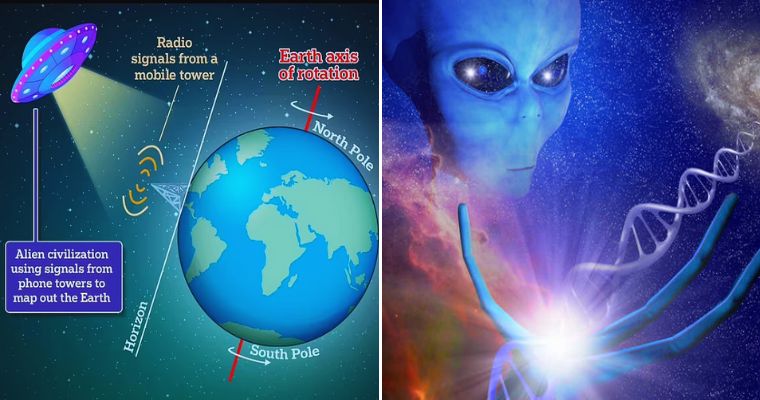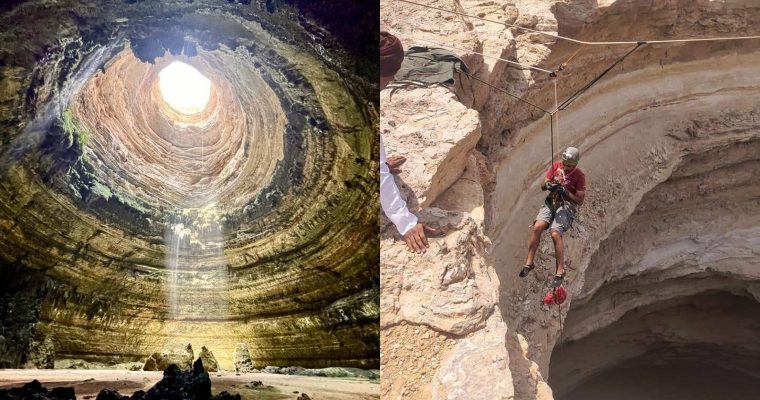Fossil Hunters Found Bones From An Ancient Whale… And Then They Saw The Bite Marks
 The whale fin fossils. (Photo: Photos courtesy Carlos Jaramillo)
The whale fin fossils. (Photo: Photos courtesy Carlos Jaramillo)
At the top of the water surface, there was tremendous turmoil. An island of flesh, once comfortably living and swimming through the ancient seas, bobbed silently, at times yanked violently to the side or jolted upward by forces below it.
A huge prehistoric seabird called Pelagornis miocaenus, which circles lazily above the scene, may have noticed that the whale carcass in its entirety, partially exposed to the air, but much of it underwater.
He had seen the many sharks that surrounded him. Some take breaths, shaking the flesh off the body and go away. Others may have attacked the whale from below, propelling themselves teeth first into the dead mammal.
The head and snout of a lone great white shark (Carcharodon carcharias) may have appeared amongst the waves, biting off chunks from the dead whale’s side.
A whale this size isn’t devoured in a day, no matter how hungry the sharks encircling it was. With the tastier options—the tongue and most of the fatty flesh—eaten away, the carcass was beginning to come apart. The head had long since detached, its skull drifting down to the seafloor. Other parts were carried off to be eaten, the bones discarded elsewhere. Eventually, whatever gases or fat content kept the carcass afloat would dissipate, and it would sink.
One of the whale’s fins, in shreds, had already sunk to the sand. Ancient fish may have snacked on the threads of flesh still clinging to the exposed bones. Marine invertebrates such as worms and bryozoans attached themselves onto what remained.
In time, the remnants of this fin were covered by the seafloor. Those same remnants saw daylight again over 2 million years later, in September 2016. Professor Joaquín Atencio, two of his students, Joel Orocú and Patricio Pimentel, and Joel’s father, Félix Orocú, discovered the exposed fossil whale bones when the tide was out in the Burica Peninsula of Panama.
 The fossil hunters: Félix Orocú (red shirt); his son, Joel Orocú (holding shovel); and students from Colegio Punta Burica and Escuela Primaria Caña Blanca. (Photo: Photos courtesy of Carlos Jaramillo)
The fossil hunters: Félix Orocú (red shirt); his son, Joel Orocú (holding shovel); and students from Colegio Punta Burica and Escuela Primaria Caña Blanca. (Photo: Photos courtesy of Carlos Jaramillo)
After spotting the fossils in the coastal outcrop, Atencio called Carlos Jaramillo, a geologist, and paleontologist at the Smithsonian Tropical Research Institute, who in turn put together a team of scientists to excavate them. They uncovered several disarticulated fossil whale bones and a fossil shark tooth nearby.
The research into these bones culminated in a paper published recently in the journal Palaeontologia Electronica: “Shark-cetacean trophic interactions during the late Pliocene in the Central Eastern Pacific (Panama).”
The authors determined that these bones belonged to a type of Balaenopterid, a genus of filter-feeding whales that includes today’s humpback and blue whales. Fin bones alone are not enough to determine the exact species or the size of the marine mammal, but these particular bones did offer tantalizing clues into the last moments of this animal.
 Graphic: Cortés et al.
Graphic: Cortés et al.
“When we collected the whale fossils,” explained lead author Dirley Cortés, a paleobiologist at Redpath Museum, McGill University, “from the beginning we were really surprised about the giant size of the appendicular bones. After a while of inspection, we realized some of the bones had strange serrated marks across the surface, we came up with the exciting hypothesis of shark bite marks, but it took us more time to actually confirm it.”
One such bone, they reported, has 26 separate bite traces upon it. Studying such traces is the hallmark of ichnology, a field that specializes in the grooves, marks, edges, and prints left behind by living species. What might look like just a bunch of cracks on the ancient bone to the average person reads like an entire language to ichnologists, one that provides remarkable insight?
“Some of the bite traces show these very finely spaced parallel lines,” said Anthony Martin, ichnologist at Emory University, “which is typical of the kind of damage you would get from a serrated tooth. That damage is generally associated with sharks.”
 Image: Cortés et al.
Image: Cortés et al.
Absent conclusive proof one way or the other, the authors conservatively propose that at least two different sharks may have scavenged upon this whale, perhaps great white sharks. Jorge Velez-Juarbe, the marine mammal curator for the Natural History Museum of Los Angeles County, explained that this assumption is due to the size difference between the bite traces.
The scenario described at the start of this article may or may not have actually occurred. While fossils tell us a great deal, they don’t reveal every detail. We don’t know whether the whale was already dead at the time of the shark bites; we don’t know whether it was scavenged while floating on the surface or whether it had already sunk and was eaten on the seafloor. We also don’t know with certainty which species of shark gnawed on its flesh.
“From what we know, at the end of the Pliocene, there is an interesting mix of more modern fauna with other more ‘archaic’ or extinct groups,” Velez-Juarbe said. “This, of course, changed a bit at the end of the Neogene, when there seems to have been a marine megafauna extinction event.”
In other words, some of the creatures living in oceans 3.6 million to 2.58 million years ago are very much a part of our world today. We have filter-feeding whales and great white sharks off of our coasts. The story these fossils tell is one we can instantly imagine and understand. Today’s sharks are not known to attack full-grown whales. If their ancestors behaved in similar ways, then it is reasonable to assume ancient sharks scavenged—rather than killed then ate—this ancient whale. The bite traces support this.
“The vast majority of bite traces on bone are scavenging,” Martin said. “In many instances, and I think in this instance, too, there might not be enough flesh to prevent the teeth from contacting the bone. Once the teeth are contacting the bone, that means either that bone is exposed or the flesh is thin enough that the teeth can contact bone.”
“This finding is of scientific importance not only because we were able to tell much about sharks feeding on whales [in prehistoric times], but because of its temporal context. As we pointed out in the paper, the genetic diversity of cetaceans, and especially mysticetes, declined around the Pliocene-Pleistocene boundary, an example of a global turnover event in the marine megafauna,” wrote Cortés in an email. “Fossil marine mammals, like the one preserved here, will be useful for understanding the dynamics of the marine fauna in one of the most critical periods of Earth history, the Plio-Pleistocene transition.”
Cortés emphasized the importance of further exploring the Burica Peninsula in Panama and other nearby sites. While whale fossils are common throughout the world, discoveries have been relatively few in Central and South America. The whale specimen described here is actually the first marine mammal recorded from the Neogene (a period that spanned from 23 million years ago to 2.58 million years ago) in the Burica Peninsula.

“One of the reasons,” Cortés offered, “maybe the lack of fully exposed Cenozoic outcrops in particular in the Pacific side of Central America, which makes it difficult to prospect this succession and get data. Another important reason is the number of researchers per capita.”
She described how paleontology is still an emerging science in countries such as Panama and Colombia. To illustrate this further, she explained that out of “1 million citizens, Colombia has less than 90 scientists, of which a minimum amount is involved in paleontology. Without enough paleontologists, research becomes challenged although the privileged way of life. And the panorama for women scientists does not look so encouraging either.”
“Something paleontologists always highlight is that no matter how complete, what matters most is the amazing story that fossil has to tell us,” wrote Cortés. The stories yet to be told—the fossils hidden for millions of years—are just waiting to be found.
Sources:archaeology-world.com








